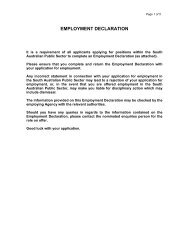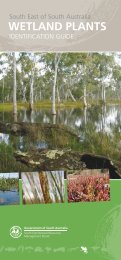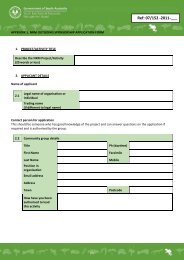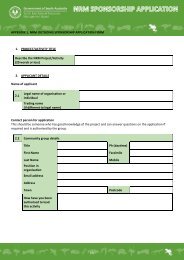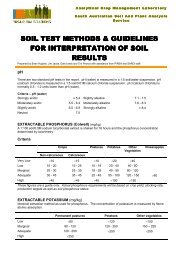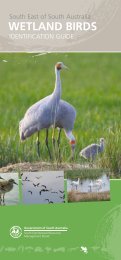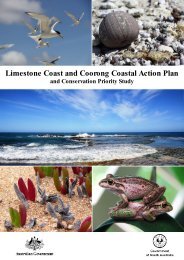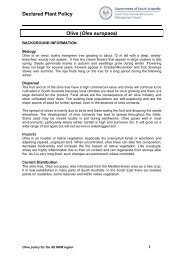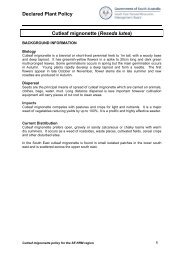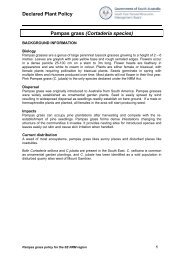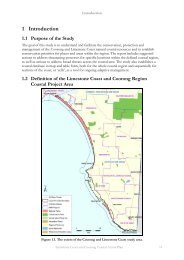Cell Descriptions - South East Natural Resources Management Board
Cell Descriptions - South East Natural Resources Management Board
Cell Descriptions - South East Natural Resources Management Board
Create successful ePaper yourself
Turn your PDF publications into a flip-book with our unique Google optimized e-Paper software.
SE7 – Canunda NP<br />
nationally vulnerable Dwarf Galaxias. In conjunction with the nearby Mullins Swamp, Lake<br />
Frome has been considered as the most important wetland in the <strong>South</strong> <strong>East</strong> outside of Bool<br />
Lagoon (SEWC, 1984). However, the system does show signs of declining health, coupled with a<br />
trend toward habitat homogenisation via the spread of Typha domingensis. In response to these<br />
trends, hydrological restoration has been identified as a key objective in the Lake Frome CP<br />
<strong>Management</strong> Plan (DEH, 2003). Farrington (2009) investigated the wetland restoration feasibility<br />
in terms of depths and volumes of inundation, potential ecological impacts and flood<br />
management implications. A hydrological model has since been developed for the drainage<br />
catchments (Geoff Woods, DENR pers. comm. 2010) and monitoring infrastructure has been<br />
installed in order to more accurately assess drainage inflows and volume retention. Based on a<br />
ground-truthed digital elevation model, water could be retained to a depth of 1.5m AHD via an<br />
outlet regulator, without the need for levee banks. It would be possible to hold water up to 2.2m<br />
AHD without significant flooding back up any of the inflow drains, however large earthworks<br />
would be required for levee banks to protect surrounding, low-lying properties. Based on<br />
preliminary hydrological data, the volume of water required to fill the wetland basin up to a<br />
volume of 2.2m AHD has been delivered in eight out of the last ten years (Farrington, 2009) and<br />
so security of necessary inflows remains high despite an unprecedented period of low rainfall.<br />
Ongoing collection of groundwater and surface water data, including inflow volumes and salinity,<br />
form an extension of background investigations. In addition, the regular monitoring of vegetation<br />
is a priority site action for DENR. The greatest obstacle to hydrological restoration is opposition<br />
voiced by neighbouring property owners. A key recommendation for the restoration of Lake<br />
Frome is engagement of the local community and an evaluation of any concerns using data and<br />
information that has been and continues to be collected.<br />
Conservation Analysis (GIS)<br />
The summary of cell conservation means shows that this cell is the third highest conservation<br />
priority in the region (136.3). The bulk of the medium to medium high values are in the older<br />
inner vegetated dune areas (see conservation summary map below); the whole of Lake Frome<br />
Conservation Park exhibits very high values; a smaller area, from Cullen Bay to the Cape Buffon<br />
shows high totals within 150m of the vegetated cliff line. In contrast, the de-vegetated dunes on<br />
the slopes leading to the shoreline show low to medium low values.<br />
Lake Frome CP records very high scores for threatened reptile habitat, butterfly habitat and<br />
habitat for 6 out of the 7 focal species – Orange Bellied Parrot, Fairy Tern, Swamp Antechinus<br />
(last viable population in SA; nb likes vegetation with a dense under storey, it is a late invader and<br />
hence is threatened by fire), Swamp Skink, Yellow Sedge Skipper and <strong>South</strong>ern Bell Frog.<br />
The cell has high values for state rarity of vegetation communities; priority for the threatened<br />
status of flora is high throughout the vegetated dune areas; also the dunes accumulate the highest<br />
values for plant associations only found in this region within the state floristic survey. However,<br />
numbers of threatened species, and total numbers of species are not high, both in the wetland<br />
and the dunes. Significant habitat for butterfly species is recorded throughout the vegetated<br />
dunes and the Lake Frome swamp. Vegetation block metrics – size, shape and connectivity – all<br />
score highly. The entire foreshore,



